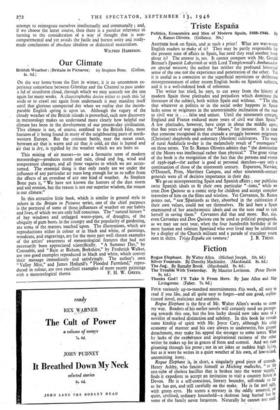Our Climate
ON the way home 'from the East in winter, it is no uncommon ex- perience somewhere between Gibraltar and the Channel to pass under a lid of stratiform cloud, through which we may scarcely see the sun again for many weeks. A claustrophobic desire either to push this lid aside or to crawl out again from underneath it may manifest itself until that glorious unexpected day when we realise that the incom- parable English spring is upon us. Although the vagary of the cloudy weather of the British islands is proverbial, each new discovery in meteorology makes us understand more clearly how helpful our climate has been in the development of our present-day civilisation.. This climate is not, of course, confined to the British Isles, most features of it being found in many of the neighbouring parts of north- western Europe. But the constant battle, near the ocean coast, between air that is warm and air that is cold, air that is humid and air that is dry, is typified by the weather which we are heirs to.
This mixing of air masses—to use a favourite term of modern meteorology—produces storm and rain, cloud and fog, wind and temperature changes, and all those vagaries to which we are accus- tomed. The essential thing is that only rarely are we under the influence of any particular air mass long enough for us to suffer from the effects of an overdose of any one kind of weather. As Stephen Bone puts it, " We have not known the horrors of the dust storm and soil erosion, but the reason is not our superior wisdom, the reason is our climate."
In this attractive little book, which is similar in general style to others in the Britain in Pictures series, one of the chief purposes is the portrayal of some of those, influences of weather on our habits and lives, of which we are only half conscious. The " natural history " of bay windows and unlagged water-pipes, of draughts, of the ubiquity of gum boots in the country and the popularity of gardening, are some of the matters touchednpon. The illustrations, which are reproductions either in colour or in black and white, of paintings, woodcuts, and engravings, are for the most part well chosen examples of the artists' awareness of meteorological features that had not necessarily been appreciated scientifically. " A Summer Day," by Constable, and " Rain at Bisham, Berkshire," by Frederick Walker, are two good examples reproduced in black and white, which convey their • message immediately and satisfyingly. The author's own " Valley Mist," and James Holland's " Flooded Farmland," repro-. duced in colour, are two excellent examples of more recent paintings


























 Previous page
Previous page